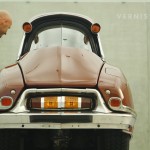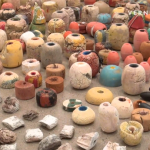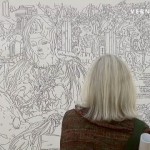For his current exhibition at Kurimanzutto Gallery in Mexico City, artist Gabriel Orozco decided to work with river stones. Orozco is a passionate collector of things. This time he decided to collect something that nature prepared over many, many years and re-use it and give it a new meaning. The exhibition runs until June 15, 2013.
Upcoming solo exhibition of Gabriel Orozco include Kunsthaus Bregenz (July 7 – October 6, 2013) and Edinburgh Art Festival Exhibition, Fruit Market Gallery (August 1 – October 20, 2013).
Gabriel Orozco at Kurimanzutto, Mexico City. Opening, April 13, 2013. Video by Diego García Sotomoro.
For more videos on Gabriel Orozco, such as Gabriel Orozco’s Retrospective at Kunstmuseum Basel, visit our archive.
> Right-click (Mac: ctrl-click) this link to download Quicktime video file.
Excerpt from the press release:
The artist “always watchful” comes across the stones. Ordinary river stones; but, it should be noted, of an inter- esting size: not your typical pebble that fits in the palm of your hand, but stones similar in size””also because of their oval form””to a football.
It is highly unlikely that the idea of how they would be later intervene emerged clearly in that first moment, but there is something in the objects (their colours, their drawings, their size) that replenishes the creative impulse; that is to say, that places the artist one more time at the beginning of something. For Orozco, this is how the process starts: based on a hypothesis that defines a provisional working course. That is why the work is always the how it could be, not the how it should be.
The stone, in any case, is a variation of a theme to which this artist constantly comes back to in his work: the circle””and all its derivatives: the sphere, the balloon, the ball, the disc, the wheel, the planet, the orbit. It is there, at the centre of the circle, where Orozco likes to pinpoint the beginning of things; a beginning that aims in all direc- tions””unlike the immovable unidirectionality of the straight line. And that is why in his work we find oranges, tires, soccer balls, billiard balls, sand balls, melons and all kinds of objects close to the sphere: potatoes, watermelons, mixiotes1, seeds, hands that are the heart. Because they are bodies that speak of what the circle speaks: of mobil- ity, of cycles, of game, of fullness, of rotation, etc.
This stones are made to be touched: that is why the drawings are not superimposed, they penetrate the stone. Although, well-regarded, a cleft is actually nothing but a space that occupies a place in matter. But occupies it conversely to graphite: here the void is not the organic form that is left free from drawing, it is the gap itself that produces the drawing. So, it is not about just a void, but a void where there used to be something: more stone. But that which diminishes the original materiality is precisely that which increases the sense of the work (it stops being a stone to become a sculpture). You might say, an exchange of substances. The less stone the more sculp- ture, the stone collaborates here becoming a drawing itself.
Nevertheless, the dialog between two sculpting forms stays intact: that of nature, which makes the stone go from a rough and jagged rock to a polished cobblestone; and that of the artist, who, as we have already stated, is the one that cuts (literally, with a sharp diamond tip).







